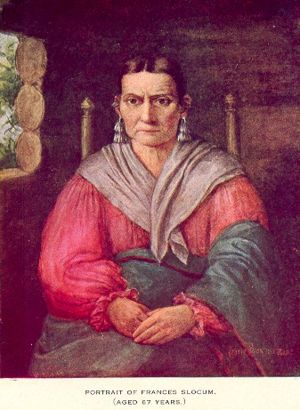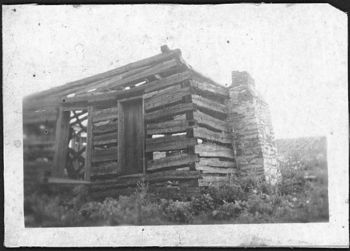Frances Slocum - A Legend
Contents
Frances Slocum’s Birth and Capture
Frances Slocum was born to Jonathon and Ruth Slocum, a Quaker family living near Wilkes-Barre, in Wyoming Valley, Luzerne County, Pennsylvania, on November 2, 1778. She was taken from her home by Delaware Indians when she was five years old (Bailey 1). Frances’s captors had come to seek revenge on her father for allowing his son, a Quaker, to fight Indians. The Indians thought they could trust Quakers because they did not believe in fighting (Gilman 23).
Frances was traded to an older, childless Miami couple for animal pelts. She was given the Indian name Maconaquah, which means Little Bear Woman, after her new father, Big Bear. Maconaquah adapted very well to her new Indian life. She was much loved by her new parents and did not have to compete with nine other children for their attention like she had to in her birth family. There were many children in her tribe with whom she made friends (Gilman 31-35).
In 1779 Maconaquah and her Indian family were forced to leave there home by the Continental Army who were burning the Indians’ crops to drive them from their land. They settled in Kekionga, present day Fort Wayne, to live near other Miami Indians. As Maconaquah grew older she became a celebrity of sorts within her Indian community (Gilman 35-37).
Marriage to Tuck Horse
She was known not only for her light skin and flaming red hair, but also for excelling at the foot races and games on horseback which the Indians loved to play, even beating the young braves at the games. She earned the nickname Red Heart of the Miamis for her great courage and ability to break horses that the braves would not attempt. She would be a prized wife to any brave (Gilman 45-51).
Maconaquah had grown to be a very beautiful young woman according to the people in her Indian community. When a French merchant with whom the tribe traded tried to rape her, it was decided that the search for a husband should begin. Her father wanted her to marry a Delaware Indian because he was of the Delaware tribe. In 1790 Maconaquah married a young Delaware brave named Tuck Horse. He was a good hunter, a strong brave, and very handsome. At nineteen, Tuck Horse was very young to get married, but Maconaquah was such a prized young woman that his mother consented to the marriage (Gilman 59-63).
Maconaquah moved into a wigwam with Tuck Horse and his entire family. It was cramped, crowded, and allowed no privacy for the young couple to get acquainted. She was very disappointed when it became apparent that Tuck Horse had no plans to leave his family or build his own home. Before long, with her mother-in-law in agreement, she began making plans to build their own wigwam and wove together the reed for it, as well as gathering other necessities.
Marital Problems
Other problems began to arise. Tuck Horse left on long hunting and war party trips. He spent all their earnings on whiskey and other frivolous trinkets instead of necessities for the running of their home. When Tuck Horse’s drinking led to domestic violence against Maconaquah in private and in public, she was encouraged by family and friends to divorce him (Gilman 63-67). In 1791 Maconaquah went back to live with her parents who were outraged that anyone would treat Red Heart of the Miamis with such disrespect and cruelty. She worked hard to help run her elderly parents’ household (Gilman 63-67).
One night Maconaquah thought she heard an animal near the house, but upon investigation found an injured Indian in the woods. His name was Shepoconah--Deaf Man, as the white men called him because of his almost total deafness. Shepoconah stayed with the family, and Maconaquah nursed him back to health. He began helping out the household wherever he could as he regained his strength. When Big Bear’s health began to fail, Shepoconah gradually took over the jobs of the male of the house such as hunting and protecting the family. Before Maconaquah’s father died, he thanked Shepoconah for all he had done for his family. Big Bear then gave Maconaquah to him for his wife. Shepoconah assured Big Bear he could die with no fears because he would take care of Maconaquah and treat his wife, as he would treat his own mother. Big Bear died soon after (Gilman 226-234).
Move to Miami County
Shepoconah, Maconaquah, and her mother moved to the area that is present-day Miami County. Maconaquah was very happy with Shepoconah. He had a gentle spirit and would even help with household chores which most Indian men felt were beneath them (Gilman 234-236). Shepoconah later became Chief of the Miami Indians in the Peru area. Maconaquah gave birth to two girls she named Kekesequah and Osawshequah. She also had two boys who died at a young age. Their names are unknown. Maconaquah lived the rest of her life in this area (Bailey 4-5).Later Life
In January 1835 Mr. James T. Miller talked to Maconaquah, now an old woman, and found out that she had family in Pennsylvania. He sent a letter to the postmaster of Lancaster, Pennsylvania, and asked him to publish the facts he had learned about Maconaquah. The postmaster did not believe the story to be true, and the letter was only published after his death, about two years later, when his wife found it. Isaac Slocum went to Peru, Indiana, in May of 1838 when he learned about his long lost sister. He and Maconaquah talked for hours even though she could barely speak English. Other Slocum relatives came to visit her. Maconaquah’s brother and sister tried to get her to move with them back to Pennsylvania, but she would never leave the people who had been her family for over 60 years (Bailey 1-5).
Maconaquah died in 1847 of old age. Her grave was marked by a white flag, which was her wish. Nearly fifty years later the Honorable James F. Stutsman of Peru, Indiana, and members of the Slocum family gathered the means to build a monument unveiled on May 17, 1900, in honor of Frances Slocum (Winger 25).
Significance
Frances Slocum was a significant historical figure because of her life as a white woman living amongst the Indians. It was not uncommon for whites to be taken captive by Indians, however to build a life with them and be accepted was most unusual. In a time when natives were looked down upon, for Frances Slocum to not only accept their culture, but also embrace it and make it her own was very surprising. Through her unique ability to work with both the Indian and the white man, her story has taught many about the Indian life. In memory of her life and contributions she made, many things bear her name--Frances Slocum Elementary School in Marion, Indiana, Maconaquah High School in Bunker Hill, Indiana, Maconaquah Park in Peru, Indiana, and Frances Slocum Trail in Grant County, Indiana, to name several (Winger 25-29).
There are many historical events that were very important in the lives of both Frances Slocum and the Miami people. A treaty made in 1840 with the United States Government stated that the Miami Indians had to leave their home along the Wabash River within five years. Many people in the tribe mourned over the coming departure. Her remaining brothers knew her unhappiness and finally decided to help her appeal to Congress and ask to be exempted from the treaty and with her descendants be allowed to reside on the reservation in Indiana given to her daughters. A petition was drawn up and signed by 21 of her relatives on January 17, 1845. Frances was allowed to stay and not be subjected to what became known as the Trail of Tears that her fellow Miami Indians Q endured (Robinson 2-4). This splitting of the Miamis created what are now called the Eastern or Indiana Miamis and the Westem or Oklahoma Miamis. The United States Government recognized only the Western Miamis as Indians. It has only been recently and after many legal battles that the Eastern Miamis are becoming recognized as another tribe of North American Indians (Rafert. 46-54).
Frances Slocum is an extraordinary person and an historic legend. Her life was provided a source of knowledge on the American Indian culture for people both past and present. She is seen as a leader in both Indian and American cultures.
Gallery
Bibliography
- Bailey, G. S. "The Story of Frances Slocum." http:/www.rootsweb.com/~imniami/ fslocunihtml. December 4, 2001.
- Gilman, Julia. William Wells and Maconaguah — White Rose of the Miamis. Jewel Publishing. Cincinnati, Ohio. 1985.
- Robinson, Ralph W. II. "Slocum." http://ww.rootsweb.com~scwhite/slocum/frances. html. December 11, 2001.
- Rafert, Stewart. The Miami Indians of Indiana a Persistent People 1654 - 1994. Indiana Historical Society. United States. 1996.
- Winger, Otho. The Frances Slocum Trail. Elgin Press. The News — Journal. North Manchester, Indiana. 1933.
Credits
This article was written by Katie Willman and submitted on January 11, 2002.








